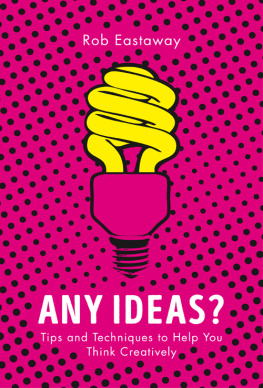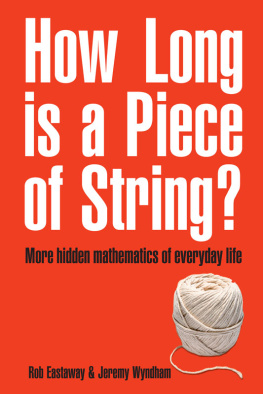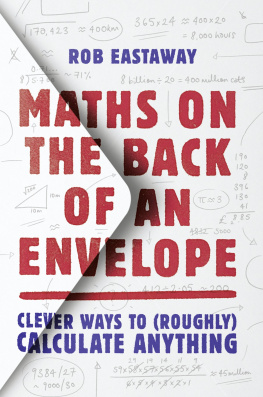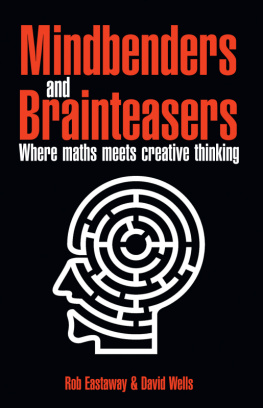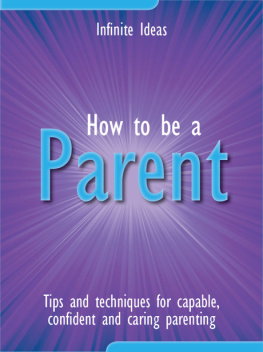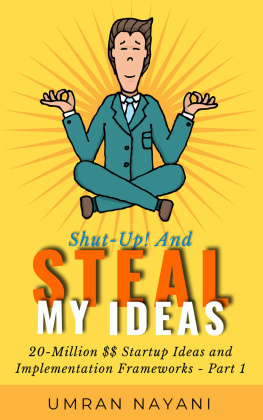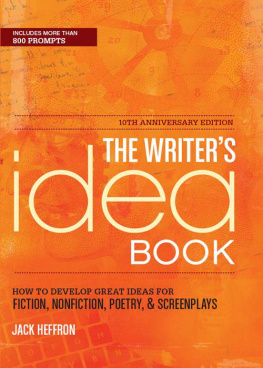ANY IDEAS?
If you want to have good ideas
you must have many ideas.
Linus Pauling, Nobel Prize-winner for Chemistry
Rob Eastaway
ANY IDEAS?
Tips and Techniques to Help You Think Creatively
CONTENTS
INTRODUCTION
Everyone needs ideas.
Maybe they are just ideas for something routine, like thinking of a birthday present, or deciding what to do this weekend.
But there are times when you need to come up with ideas for more important things: ideas for a speech or a big presentation at work; how to decorate your house on a budget; how to balance your family and work commitments; or even for more and more people these days coming up with an idea for a new product or business.
Of course, ideas are needed to solve problems too: when youre stuck, sometimes the only way forward is by thinking around the problem with whats often called lateral thinking.
Without ideas you cant be creative, and in a world that is constantly changing, where its becoming rare to find jobs in which you can spend years following a routine, were all being forced to become more creative whether we like it or not.
This is a book about how to have ideas, on your own or in collaboration with others, and how to nurture them so they help you to solve everyday problems.
Ideas do, of course, happen by themselves, they are a natural part of how the human brain works.
But sometimes they need a helping hand, so there are tips here about techniques that can significantly increase the number of ideas that you have.
Creative thinking can help you to come up with better solutions to problems. It can also lead you to new experiences and opportunities that just make life a bit more exciting and fun. And thats what most of us want.
IDEA-KILLING
Unfortunately, ideas have enemies. Idea-killers.
Ideas can be fragile things, and it doesnt take much to kill them off. Ideas are often killed off just by being ignored, but they can also be killed by being criticized or laughed at.
There are two main idea-killers. These are:
OTHER PEOPLE
and
YOU
If you want to have more good ideas in life, then its vital to be able to recognize idea-killers so that you can protect yourself against them.
Idea-killing (and how to avoid it) is a recurring theme in this book. Its discussed in (Brainstorming).
When trying to overcome idea-killing, there is one principle that is so important it also deserves a mention up front and that is that you need to nurture and protect silliness.
THE IMPORTANCE OF SILLINESS
Not all ideas seem sensible when they are first aired. In fact, if an idea is genuinely novel, then by definition it is something that hasnt been encountered before; and when we havent seen something before, we are, as human beings, naturally sceptical. Oh you couldnt do that , Oh that would never work .
This means that many new ideas will at first seem a bit silly.
And of course not all silly ideas are good ones, many deserve to be killed immediately. But among them are some that dont. Its often the ideas that at first seem silly and impractical which turn out to be the best.
About 20 years ago, somebody somewhere made a suggestion: At stores, instead of having to have your groceries scanned by a checkout operator, why not arrange it so that you scan all the items yourself. That person could easily have been laughed out of the room. The supermarket would be bankrupt in a week! Instead, that idea got picked up, and these days self-scanning is normal practice (even if it isnt universally popular).
Other ideas that would no doubt have been dismissed as fanciful, impossible or just downright silly just 20 years ago include:
A taxi service where the drivers dont know their way around the city (Uber).
Injecting a deadly toxin into your face to make you look younger (Botox).
A TV show where you watch people watching TV (Gogglebox).
A device that allows you to print sophisticated solid objects (3D printers).
And the list goes on.
So as you read through this book, remember that if you want to have more ideas, there are times when you need to allow yourself to be just a little bit more silly if not in the things that you do, at least in the things that you think.
AH, AHA AND HAHA
This book is the result of an idea. I first had that idea (to write a book about creative thinking) 20 years ago. The first version was binned after a couple of months, and there were several years when the idea was left on the shelf, then there was a first attempt (under the title Out of the Box and written to somebody elses brief) in 2007, before it finally ended up as the book you are now reading. Like many ideas, it only turned into this finished product after several iterations and dead ends.
Why did I want to write this book?
For as long as I can remember, Ive been interested in puzzles.
I always particularly enjoyed puzzles that involved Aha! moments. In my junior school I had a teacher, Mr Hudson, who used to like posing us questions like this:
Tom lives on the 20th floor of a block of flats. One Monday morning, Tom gets in the lift, rides down to the ground floor and heads out. When he returns later that day he presses the button for the 16th floor, gets out and walks up the final four flights of stairs to get to his flat. Why doesnt Tom take the lift all the way up to the 20th floor?
There could have been lots of reasons why Tom made the detour. The point of these so-called lateral-thinking puzzles is to figure out what happened by asking questions.
Was the lift working properly?
Yes.
Did Tom want to get out at the 16th floor to do something?
No, he wanted to go the 20th floor.
Was something blocking the lift exit?
No.
The solution? It turns out that Tom was a young boy on his way to school. He could reach the button for the ground floor, but he wasnt tall enough to reach button 20 when he returned. The highest button he could reach was 16 so he pressed that and had to walk up the rest.
The Aha! feeling when you solve a puzzle like this is closely related to creative thinking. In the 1950s, the philosopher Arthur Koestler wrote a book called The Act of Creation, in which he proposed that creativity is Art, Discovery or Humour. Somebody else summed this up as: Ah, Aha and Haha.
My interest in Aha! puzzles stuck with me, and for a few years I became a monthly puzzle-setter for New Scientist magazine. It was an exciting but sometimes nervewracking immersion into a world where I had to come up with something new every month. And it had to be an idea that worked: a puzzle that had a flaw and couldnt be solved was worthless, as I discovered when my second New Scientist puzzle proved to be a dud, prompting dozens of letters from angry readers. Setting puzzles to a deadline was excellent training in practical creativity.

